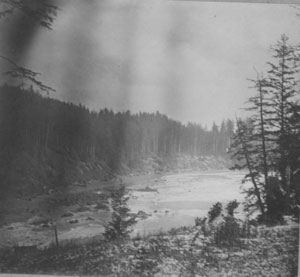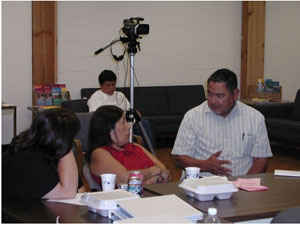











 |



 |












 |
 |

Museum-Library Collaboration Highlight
Printer Friendly Version
Virtual Museum Project Explores Cultures of the Northwest Olympic Peninsula
The Institute
of Museum and Library Services is a primary source of federal support
for the Nation's libraries and museums. Many grants promote
preservation of native cultures, international education and exchange.
The Community Museum project at the University of Washington featured
here is one example. A list of selected examples is also available.

View of the Olympic National Park. From the collection of the National Park Service, permission of Doreen Taylor. |
With the expansion of computer technology and digital communication to some of the most remote corners of the earth, there is growing concern that the cultures, languages, and lifestyles of the world minority populations-especially indigenous peoples-are seriously threatened. Through its grant programs, the Institute of Museum and Library Services (IMLS) promotes awareness, appreciation, and preservation of the diverse cultures found in the states and territories of the United States. In fact, many IMLS programs use the very technologies that appear to threaten the continuation of diverse cultures as a means to ensure their preservation. One such program is the Community Museum Project, www.communitymuseum.org, of the University of Washington and its tribal, cultural, and educational partners in the Northwest Olympic Peninsula. Funded by an IMLS National Leadership Grant for Museum-Library collaboration, the project is bringing together community members to create an online museum and archives that will increase cultural understanding, expand access to unique public and private cultural collections, and promote communication among the many diverse groups living in the area.
The residents of the peninsula's West End are spread over 1,500 square miles of remote, rural land, lacking any connecting superhighway, and bound by the Olympic Mountains, the Pacific Ocean, and the Strait of Juan de Fuca. The population of 13,000 includes many diverse cultures, among them Native Americans, Hispanic Americans, and Asian Americans.
The concept for a virtual community museum originated when 150 community members met in Forks, Washington, in April 2000, to discuss how to bring connectivity to their area. Hoh Tribe consultant Viola Riebe said, "The Hoh Tribe is rich in traditions: songs, potlatch dinners, and Indian name-giving ceremonies. Frequently, even tribal members don't know some of their own traditions as well as they might. A virtual museum would help pass knowledge of traditions on to others."
Lacking the funds for their idea, the community members approached the University of Washington, where the idea was taken up in the community partnership office, known as Educational Partnerships and Learning Technologies, and the offices of the university libraries. In 2003, the university applied for and received funding from IMLS that enabled it to begin work. A project model was created for the large university to partner with small, rural community groups and tribes. The university provides training, technical assistance, and project management. The community members design and curate the online exhibits.
Community members as curators
Project manager Larry Burtness describes two goals for the Community Museum Project. The first is to build an online archive of artifacts (photos, oral history sound recordings, diaries, etc.) that are contributed by the community for educational and research use. The second is to build online museum exhibits that draw from those archives and will allow people to gain insight into the culture and history of the area.
The project team is equipping the community partners with the tools and technical know-how to select items from their collections for digitization. The project will include training sessions for partners, a development kit on best practices and equipment specifications, and a portable scanning kit with digital cameras and scanners that partners can check out. The project entails two additional major components: Each of the online exhibits will be made into physical exhibitions for display throughout the region, and the Community Museum Project Web site will feature curriculum components that are currently under development at the University of Washington's Center for the Study of the Pacific Northwest.

Project members from different intuitions meet for a workshop in Forks, Washington. Image courtesy of the University of Washington. |
While the project will be led mainly by library and community partnership staff of the University of Washington, it hinges on the participation of many diverse community groups and members. Local tribes and cultural organizations including the Hoh, the Quileute, and the Timber Museum are working on the design and preparation of online exhibitions and related community activities on their culture and history. The North Olympic Library System, Clallam County Historical Society, University of Washington Libraries, and the Olympic National Park are identifying items for digitization relating to each exhibit. The West Olympic Council for the Arts will produce the physical exhibitions, workshops, and print materials. The City of Forks will donate computer lab time. The University of Washington Center for the Study of the Pacific Northwest will prepare curriculum materials and conduct teacher workshops, and the Quillayute Valley School District will assist in field-testing these curriculum materials. Other partners include the Forks Chamber of Commerce, the Forks Timber Museum, Internet2, the Makah Cultural and Resource Center, and Peninsula College, which donated office space for the project in downtown Forks. Perhaps the most unusual partner is Preston, Gates & Ellis LLP, a Seattle-based law firm that is contributing hundreds of hours of pro bono legal services to work through the intellectual property issues related to the project.
Since the beginning of the project, the partners have come together for biannual advisory board meetings. They have also begun to get to know one another through training workshops. The most recent workshop was held this month in Fork. The daylong session introduced participants to digitization concepts, the use of scanners, image selection, historical photo interpretation, metadata collection, exhibit planning, and copyright and permission issues.

Community partners discuss project issues during a recent workshop. Image courtesy of the University of Washington. |
Local history is personal history
A weekend fair held this summer in Forks proved to be a great way to spread word of the project and build community interest. Project staff set up a tent housing plans for the coming virtual museum and archive, as well as a few hundred pictures that have already been digitized. The tent was among the most popular at the fair. People enjoyed browsing through the historic photographs and trying to identify individuals depicted in them. As a result of the display, three people brought in photo albums to contribute to the archive.
These individual contributors have photos of their grandfathers in the timber industry. They have pictures of the homesteads and family life of early pioneers. One woman brought in a handwritten autobiography of her grandfather, who was born in 1861 in Pennsylvania and later came west to homestead the land. His life story is written in 30 fascinating pages.

Postmistress Fannie Taylor of the Mora village takes a photo with her panoramic camera. From the collection of the National Park Service, with permission of Doreen Taylor. The photo and others from the collection will be part of the first virtual exhibit of the Community Museum. |
Burtness said, "Once community members understand what our project entails, they are fairly willing to bring forward their personal stories. That's one of the important aspects of this project. It's called the Community Museum Project, and the community is really responding very well to it. The institutions are certainly participating and are providing significant collections. We're finding, though, that many people in the community have collections that are every bit as valuable as what is in institutional collections."
People do not have to give up their heirlooms in order to contribute to the digital archive. Burtness said, "They don't want to give up their photographs or diaries, but they are willing once they understand that we can do the digital capturing without taking possession of the physical object."
Kathy Monds, Director of the Clallam County Historical Society, looks forward to sharing items from her collection with the online archive and exhibit. Without a Web site, the organization depends on traditional means for communicating to the public about its collections. With the Community Museum Project, the historical society will soon be able to reach a broader audience.
She, too, anticipates that privately held cultural treasures will surface as a result of the project. She remarked, "We hope as a result of this project, the public will become more aware of their collections and will realize that the photos they have stored away may be of real value. We don't want valuable records to end up in the dump."
The Hoh Tribe
The Hoh Tribe reservation is one square mile on the northwest coast of the state, right on the Pacific Ocean. With the nearby Hoh River Rainforest and the Hoh River, which flows right through the tribe's village of 102 people, the Hoh tribal members are surrounded by water. The tribe's Executive Director James Jaime said, "The tribe's culture and traditions are connected very deeply with the surrounding environment and the way it can get very rainy and wet out here."
He added, "We are very excited about the Community Museum Project. We are excited about the potential for the technology to enable us to have our language right on the computer. This project will enable us to update software that 'speaks' the language. For the younger kids, it will not only entertain them, but is very instructional. The kids are very excited about having this new resource on their home computers."
The Hoh and Quileute tribes have a related language that is taught at the Quileute Tribal School. Between the tribes, there are only about 20 fluent speakers. The project will help preserve the language and make it more accessible, through the special software and through the tribal resources that are digitized and posted.
The Hoh Tribe has not yet digitized any materials. The Tribal Council must first approve the permission and usage agreement drafted for the tribe by the project partners. According to Burtness, the views of Native American communities concerning permissions and usage of intellectual or cultural property can differ from what is acceptable under U.S. and international copyright law because of belief systems, sensitivity about religious ceremonies and rites, and sovereignty issues.
The museum partners have gathered their materials about the tribe, which include photos, documents, and stories. Some material that has been passed on from families to the tribe--notably in books about the tribe's language, basket making, native plants and uses, and the places they used to go for potlatches-will become more widely available. An even greater source of contributions could come from the personal collections of tribal members.
The songs of the tribe and its families have great significance for the tribe's cultural protocol. They are sung or chanted during meetings, parties, potlatches, and other gatherings. They include spiritual songs that have healing aspects, welcoming songs, traveling songs, and eating songs. While some songs are communal, others belong to certain families. They have been passed down through the generations, and families are generally very protective of this heritage because it represents their family lineage. Anyone outside the family wishing to use the song, even for a video or audio recording, must first get permission from the family. According to Jaime, this is a very important formal tribal convention that members must honor.
It is often at the potlatches that permission for use-with restrictions and stipulations-is verbally granted by elders to others. Jaime said, "As traditional people attend these sessions, they are the way of archiving and safeguarding the record of who owns these songs and who can use them. Our way of recording events and activities may not be through documentation as much as it is through oral history and the presentation of that history." Jaime expects that the songs the tribal school uses for educational purposes can be shared with the virtual museum.
The tribal conventions concerning cultural ownership have challenged project team, but Burtness says they will soon have agreements that work for the various participating partners. Creating the usage agreements and policies has been one of the project's biggest achievements. As the project continues to grow and gain momentum throughout the community, the project leaders believe that everyone involved will be proud of the time they have spent and their willingness to try a new approach to ensure the preservation of their culture and language.

| Statistics: |
 |
| Grant: |
2003 National Leadership Grants for Libraries - Library-Museum Collaboration, $450,832
|
 |
| Contacts: |
Paul Constantine
Associate Director of Libraries for Research and Instructional Services
University of Washington Libraries
(206) 685-1903
pjc6@u.washington.edu
Larry Burtness
Project Manager, Community Museum Project
University of Washington
(360) 374-9122
lburtnes@u.washington.edu
|
 |
| Project Web site: |
www.communitymuseum.org
|
 |
| Participating Partners: |
- City of Forks
- Clallam County Historical Society
- Forks Chamber of Commerce
- Forks Timber Museum
- Hoh Tribe
- Internet2
- Makah Cultural and Resource Center
- North Olympic Library System
- Peninsula College
- Preston, Gates & Ellis LLP
- Quileute Tribe
- Quillayute Valley School District
- University of Washington Center for the Study of the Pacific Northwest
- University of Washington Educational Partnerships and Learning Technologies
- University of Washington Libraries
- West Olympic Council for the Arts
|

About IMLS
| What’s
New | Apply
for Grants and Awards
Publications & Resources
| A
Closer Look
HOME |
CONTACT IMLS
| SEARCH
| SUBSCRIBE
| SITE
MAP
ADOBE ACROBAT
READER
Questions, comments, or problems? Contact IMLS via email
imlsinfo@imls.gov or by phone (202)
606-8536.
|
 |








![]()
![]()
![]()
![]()
![]()
![]()